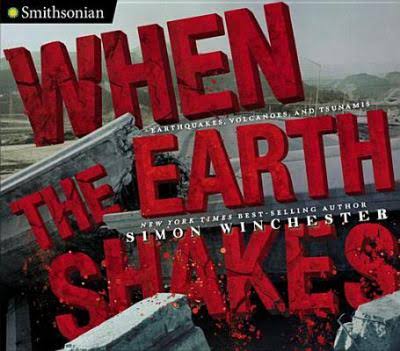
When the Earth Shakes: Earthquakes, Volcanoes, and Tsunamis
Simon Winchester, 2015
ISBN 067-07-853-69
80 p., $18,99
Viking Books for Young Readers
Aimed at a teenage audience, this book about disasters that “make the earth shake” is written by Simon Winchester, a New York Times best-selling author. Winchester is primarily known as a journalist—he worked for The Guardian for decades and covered the Troubles in Northern Ireland and the Watergate Scandal in the United States among many other events—but was originally trained as a geologist. At Oxford University, England, he became involved in the University Exploration Club, and was a member of a six-man sledding expedition onto an uncharted section of the East Greenland icecap in 1965. After finishing his degree he joined the Canadian mining company Falconbridge of Africa where he worked as a field geologist in Uganda.
When the Earth Shakes, is based on Winchester’s experiences as a geologist and as a journalist. He takes the reader on an exciting journey to places where he himself has gone to explore the wonders of geological forces and explains to his readers how earthquakes, volcanoes, and tsunamis are inextricably intertwined.
Weaving together personal narrative, scientific knowledge, and history, Winchester explores infamous natural disasters that made the planet shake, explode and flood. From the 1883 volcano eruption on Krakatoa, Indonesia and the 1906 San Francisco earthquake that destroyed 80 percent of the city, to the 21st century tsunamis that devastated Indonesia and Japan.
Winchester reminds his readers that all of these events are natural disasters and, however horrible, they are a normal part of the functioning of the planet Earth. He calls on them to be responsible custodians of the planetary resources and respect the way the planet itself operates. He ends with a warning: “We inhabit this planet subject to geological consent—which can be withdrawn at any time, and without notice.”
This book—richly illustrated with beautiful historical and contemporary photographs, maps, diagrams, and charts—might be written for 10 to 16 year-olds, but it is equally fascinating for any adult interested in the devastating and powerful natural forces that shape the earth.
Elke Weesjes Sabella is former editor of the Natural Hazards Observer. She joined the staff in December 2014 after a brief stint as a correspondent for a United Nations nonprofit. Under her leadership, the Observer was revamped to a more visual format and one that included national and international perspectives on threats facing the world. Weesjes was the editor of the peer-reviewed bimonthly publication United Academics Journal of Social Sciences from 2010 to 2013.
Weesjes Sabella also worked as a research associate for the Center for Disaster and Risk Analysis, formerly located at Colorado State University (although no longer active). In that role, she collected and analyzed data and translated research findings for a broader audience. She played a central role in finalizing the Disaster Preparedness among Childcare Providers in Colorado project, which examines all-hazards preparedness in daycares and in-home childcare across Colorado. She co-authored the report based on the first stage of the project, which was funded by Region VIII of the Federal Emergency Management Agency.
Weesjes Sabella specializes in cultural memory and neighborhood/community change in times of acute and chronic stress. She has published articles on the impact of drought on farming communities in Kansas, the effects of Superstorm Sandy in Far Rockaway, Queens, urban renewal in the Bedford-Stuyvesant neighborhood in Brooklyn, and health services for vulnerable populations in the South Bronx.
Weesjes Sabella received her PhD from the University of Sussex. Her dissertation, Children of the Red Flag: Growing up in a Communist Family During the Cold War (2012), as well as the majority of her publication record, share the common methodology of understanding culture and identity through oral history.